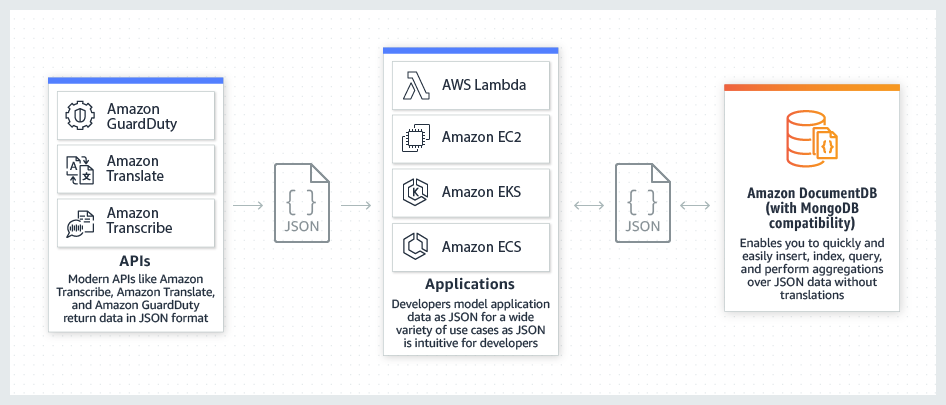Amazon DocumentDB (with MongoDB compatibility)
Scale enterprise workloads with ease using a fully managed native JSON document database
Free 750 hrs of db.t3.medium instances
for one month with the AWS Free Tier
How it works
Amazon DocumentDB (with MongoDB compatibility) is a fully managed native JSON document database that makes it easy and cost effective to operate critical document workloads at virtually any scale without managing infrastructure. Amazon DocumentDB simplifies your architecture by providing built-in security best practices, continuous backups, and native integrations with other AWS services. You can enhance your applications with generative artificial intelligence (AI) and machine learning (ML) capabilities using vector search for Amazon DocumentDB and integration with Amazon SageMaker Canvas.
-
Elastic clusters
-
Migrate self-managed MongoDB workloads
-
Elastic clusters
-

-
Migrate self-managed MongoDB workloads
-

Set up, secure, and scale MongoDB-compatible databases without worrying about running cluster management software, configuring backups, or monitoring production workloads. To learn how, see the Amazon DocumentDB Migration Guide »
Use cases
Store and query content management data
Improve the customer experience through fast, reliable access to reviews, images, and other content stored in your content management system (CMS).
Manage user profiles, preferences, and requests
Generate customer recommendations and enable online transactions. Manage millions of user profiles and preferences.
Scale mobile and web applications
Build applications that scale to process millions of user requests per second with low-latency global reads.
Enhance applications with Gen AI and ML capabilities
Unlock a wide range of use cases including semantic search experiences, product
recommendations, personalization, chatbots, and more.
How to get started
Find out how Amazon DocumentDB works
Learn about key features such as scalability, security best practices, generative AI capabilities, and MongoDB compatibility
Learn more about Amazon DocumentDB pricing
Pay only for what you use with no upfront costs or minimum fees.
Get started with Amazon DocumentDB
Access the latest training, documentation, and content.


